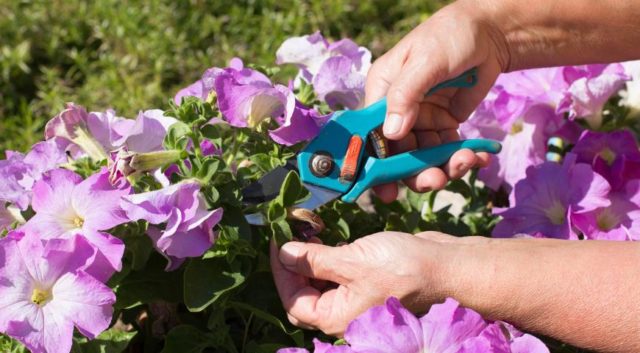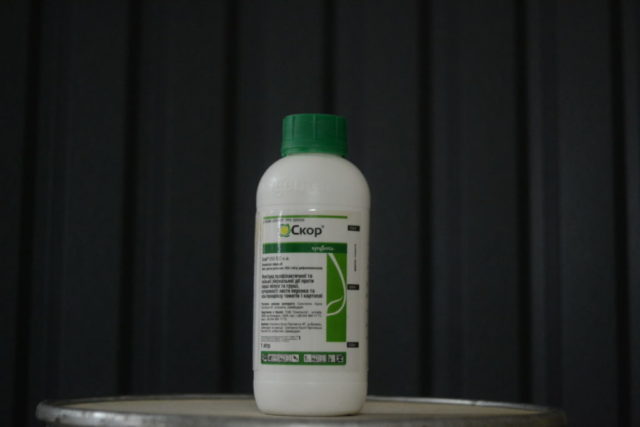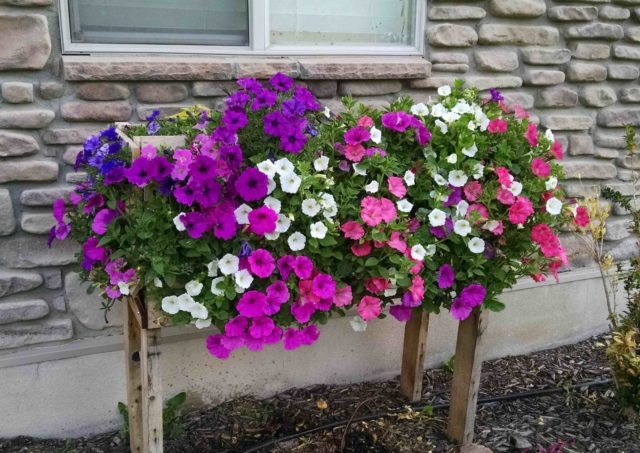Content
Petunia is a flower with a huge variety of varieties and vibrant colors. An unpretentious and ornamental plant, many gardeners willingly plant in flower beds, hanging pots decorate balconies and verandas. The flower's immunity is very good, but it is not completely immune from diseases. Powdery mildew on petunia is one of the most typical plant diseases.
What powdery mildew looks like on petunias
As you can easily understand from the photo of powdery mildew on petunia, the name of the disease quite accurately characterizes how the flower looks shortly after infection. First, a powdery whitish or grayish coating, reminiscent of spilled flour or powdered sugar, appears on the leaves. Then it spreads to the stems, buds, flowers, covering the entire plant. The plaque gradually turns into drops of cloudy mucus, resembling dewdrops.

Powdery mildew is a pathogen that can attack most horticultural crops
The pathogenic fungus that causes powdery mildew parasitizes petunia, invading cells and feeding on its juices. This disrupts the processes of photosynthesis and metabolism, after 3-4 days, if nothing is done, the tissues affected by it turn yellow, the leaves dry out and fall off. The growth rate of the flower slows down dramatically. Very few new buds appear, they are small, deformed. Without the necessary treatment, the plant completely dries up and dies in 1.5-2 weeks.
There is another pathogen with similar external signs of infection - downy mildew. It can be distinguished by a bloom of a greater degree of "fluffiness", similar not to powder, but to pile. It appears only on leaves and stems, without affecting buds and flowers.

Downy mildew on petunia is no less dangerous than real
Reasons for the appearance
Powdery mildew is one of the most common petunia diseases. Pathogenic fungi that provoke its development most often live in the soil. Under inappropriate conditions, they do not manifest themselves in any way, however, if the air temperature drops to 16-18 ºС, and the humidity rises to 60-80%, they are sharply activated. Other factors contributing to the development of powdery mildew:
- landing in deep shade (lack of sunlight);
- excessive enthusiasm for nitrogen-containing fertilizers;
- thickening of plantings in a flower bed (as a result - the impossibility of ventilation);
- non-compliance with the recommended schedule and rate of watering (the substrate is moistened too often and / or abundantly).
The pathogen enters the flower tissue through the lowest leaves, often lying on the ground. Also, the spores of the pathogenic fungus are carried by rainwater, wind, insects, the infection is transmitted from infected plants to healthy ones by direct contact. The gardener himself can "participate" in this, transferring pathogens on his hands and / or clothes, inventory in the process of caring for a flower bed.

Neglecting to disinfect garden tools and tools is a big mistake
How to deal with powdery mildew on petunias
There is a large arsenal of tools to help get rid of powdery mildew on petunias. These are both folk methods and chemicals. To stop the spread of the fungus, you need to cut off all parts of the plant that showed symptoms with a clean disinfected tool, grabbing an additional 3-5 mm of healthy tissue, and remove the upper 2-3 cm of soil from the flower bed, pouring fresh disinfected substrate instead.
Treatment with drugs
Chemicals are "heavy artillery" for treating powdery mildew on petunias. They are used if the disease was not noticed at an early stage, and the process of its development has already gone quite far.
Fundazol
A universal fungicide that helps to cope with most pathogenic fungi affecting garden crops. The treatment is effective even if the infection process has gone far. The drug remains in the tissues of petunia for another 2-3 weeks, this is an effective prevention of re-infection for a plant with a weakened immune system.
To prepare a working solution, 1 g of Fundazole is diluted in a teaspoon of water at room temperature. When the fungicide is completely dissolved, add more water, bringing the total volume to a liter. The finished product is thoroughly sprayed with petunias and shedding soil in the flowerbed.

For the complete destruction of powdery mildew, 2-3 treatments are carried out after 3-4 days
Amistar-Extra
A tool that allows you not only to get rid of powdery mildew, but also to help petunias recover from the disease. The drug stimulates metabolism at the cell level, prolongs the growing season, increases the flower's resistance to unfavorable weather and climatic conditions.
The working solution is prepared, the chemical is diluted with water in a ratio of 1:10. It begins to act within an hour after treatment.

After a single spraying of petunias and soil, the protective effect lasts for 15-20 days
Topsin-M
A complex preparation that helps to get rid of many pathogenic fungi. For the treatment of petunias, 1 ml of the fungicide is diluted in a liter of water. The solution begins to act on the same day.

The drug supports plant immunity, stimulates photosynthesis
Speed
Contact universal preparation, suitable for the prevention of powdery mildew on petunias and for the fight against the disease. Its action begins within 2-2.5 hours after spraying and watering the plants, the chemical does not allow the mycelium of the pathogenic fungus to spread in the tissues and receive the necessary nutrition. The working solution is 2 ml of the product diluted in 10 liters of water.

2-3 treatments are carried out with an interval of 15-20 days
Folk methods of struggle
Folk remedies give the desired effect only if the disease is noticed at the initial stage of development. They can also be used for prevention.
What gardeners use:
- Copper sulfate... The proportion is 1 g per liter of water. Treatments are carried out 2-3 times in 7-10 days.
- Potassium permanganate... With a dark pink solution (2-3 g per 10 l of water), petunias are sprayed every 4-5 days. Lasts 3-4 times.
- Baking soda or soda ashand. 10 g is enough for a liter of hot water. Soda is well stirred. With a solution cooled to 37 degrees, petunias are treated 3-4 times, weekly.
- Milk whey or kefir... Dilute with water 1:10. Plants are sprayed 4-5 times with an interval of 1.5 weeks.
- Garlic (teeth or arrows). "Raw materials" (about 50 g) are finely chopped, poured with a liter of water, insisted for 24 hours. Strain before use. Petunias are sprayed 4-5 times, weekly.
- Mustard powder... The proportion is 50 g per 10 liters of hot water. The infusion is ready for use in 4-5 hours. Enough 2-3 treatments every 4-6 days.

Potassium permanganate is an affordable disinfectant, the effectiveness of which has long been tested and proven.
Prophylaxis
Instead of treating powdery mildew on petunias, it is better to take preventive measures. They are quite simple, first of all, this is the observance of agricultural technology:
- Planting plants according to the recommended scheme. The dimensions of petunia bushes vary depending on the variety, the minimum interval between them is 25 cm.
- Timely and correct watering. The soil should be allowed to dry 5-7 cm deep.
- Application of nitrogen fertilizers at the beginning of the active growing season, when petunias are growing green mass, and in the right proportions. Excess nitrogen negatively affects the plant's immunity.
- Regular removal of dead buds, dry leaves.

If the petunias are planted too densely, powdery mildew spreads very quickly.
Also, for the prevention of powdery mildew, you can spray petunias with biofungicides (Fitosporin, Fitolavin) or infusions every 15-20 days:
- Wood ash (3 liters) is poured into 10 liters of boiling water, insisted for 5-7 days. Strain before use.
- Onion peel. For 10 liters of water, take 200 g of raw materials. The infusion is ready in 2-3 days.
Conclusion
Powdery mildew on petunias is a disease that affects almost all garden crops. The best prevention in this case is competent care. If, upon discovering a problem, nothing is done, a harmless whitish bloom is able to destroy plantings in a flower bed in a short time.








